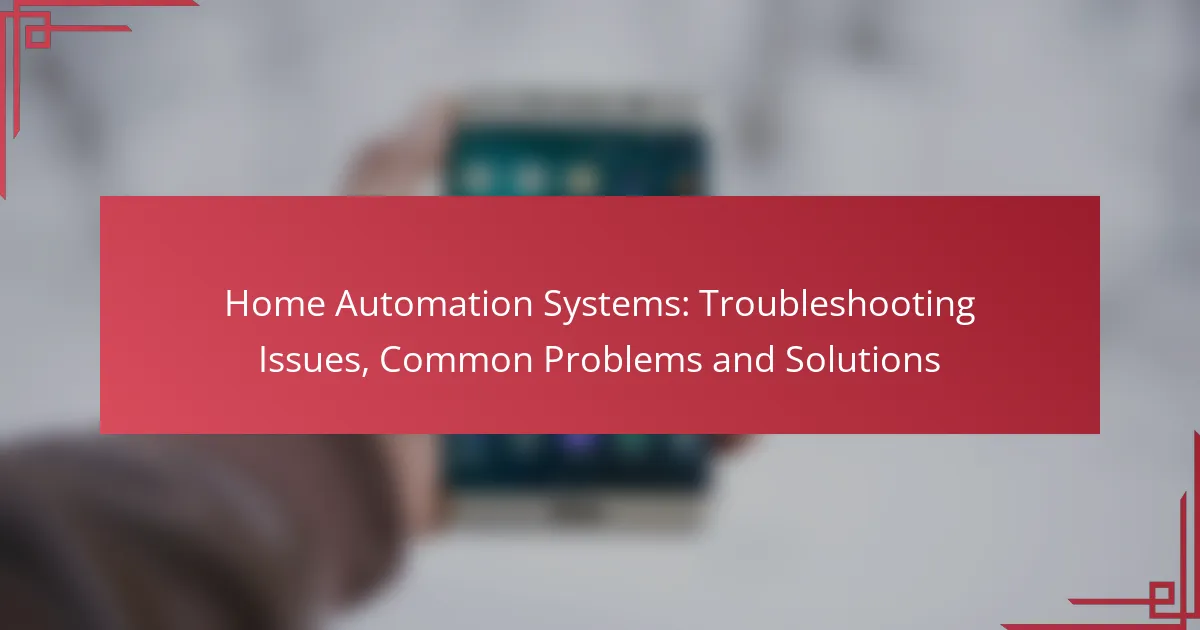Home automation systems offer a modern solution for enhancing security, energy efficiency, and convenience in both new constructions and existing homes. The installation timeframe can vary significantly, ranging from a few days to several weeks, depending on the system’s complexity and the installation environment. Careful planning and selection of compatible technologies are essential to ensure a seamless integration that meets your specific needs.
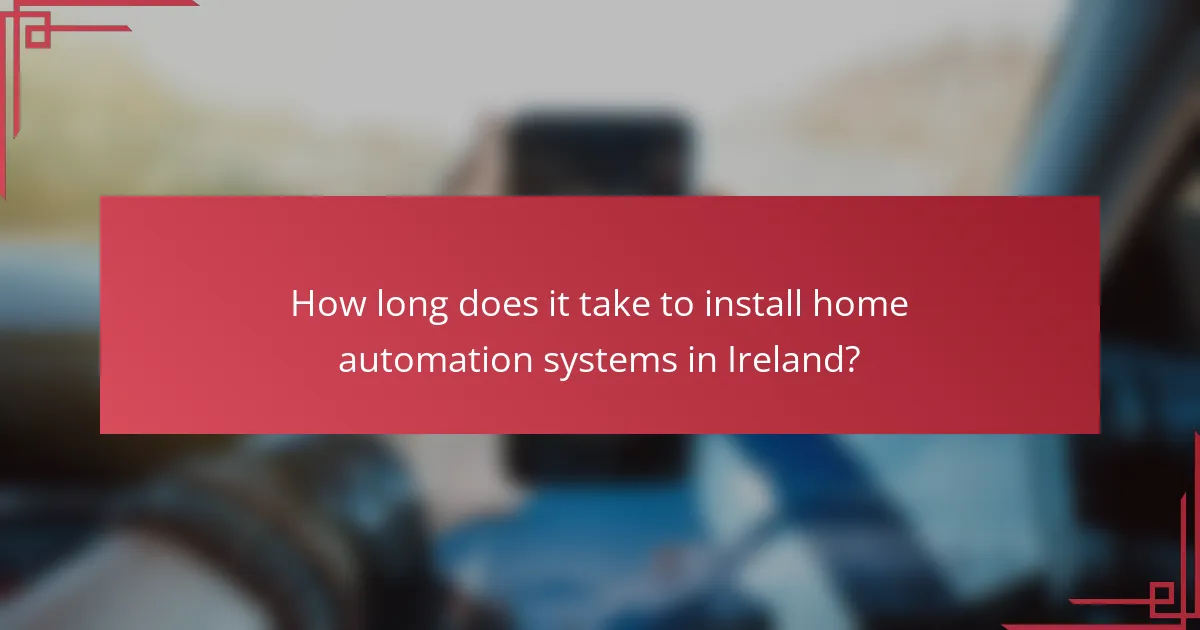
How long does it take to install home automation systems in Ireland?
Installing home automation systems in Ireland typically takes anywhere from a few days to several weeks, depending on the complexity of the system and the specifics of the installation site. Factors such as the type of technology used and whether the installation is in a new build or an existing home can significantly influence the timeframe.
Typical installation timeframe
For basic home automation setups, such as smart lighting and security systems, installation can often be completed within 1 to 3 days. More advanced systems that integrate multiple technologies, like HVAC control and smart appliances, may require 1 to 2 weeks for full installation and configuration. New constructions may allow for quicker installations as wiring and infrastructure can be planned from the outset.
Factors affecting installation duration
Several factors can impact the duration of home automation system installations. The complexity of the system, including the number of devices and their compatibility, plays a significant role. Additionally, the existing infrastructure, such as wiring and network capabilities, can either facilitate or hinder the installation process.
Another important factor is whether the installation is taking place in a new construction or an existing home. New builds often allow for easier integration of systems, while retrofitting in older homes may require additional work, such as rewiring or installing new network points, potentially extending the installation timeframe.

What are the best home automation systems for new constructions?
The best home automation systems for new constructions typically include integrated solutions that enhance security, energy efficiency, and convenience. Popular choices often feature compatibility with smart devices, ease of installation, and scalability for future upgrades.
Top-rated systems for new builds
Leading home automation systems for new constructions include brands like Control4, Crestron, and Lutron. These systems offer comprehensive features such as lighting control, climate management, and security monitoring. Additionally, platforms like Google Nest and Amazon Alexa provide user-friendly interfaces and extensive device compatibility.
When selecting a system, consider factors like the size of your home, your specific automation needs, and your budget. Many systems offer tiered pricing, allowing for customization based on desired features and functionalities.
Integration with construction timelines
Integrating home automation systems into new construction projects should begin during the planning phase. Early installation can streamline wiring and reduce costs, as it allows for the incorporation of smart technology into the building’s infrastructure. This approach minimizes the need for retrofitting later on.
Coordinate with your builder and automation specialist to align installation schedules. Aim to finalize system choices before major construction milestones, such as framing and electrical work, to ensure seamless integration and avoid delays.
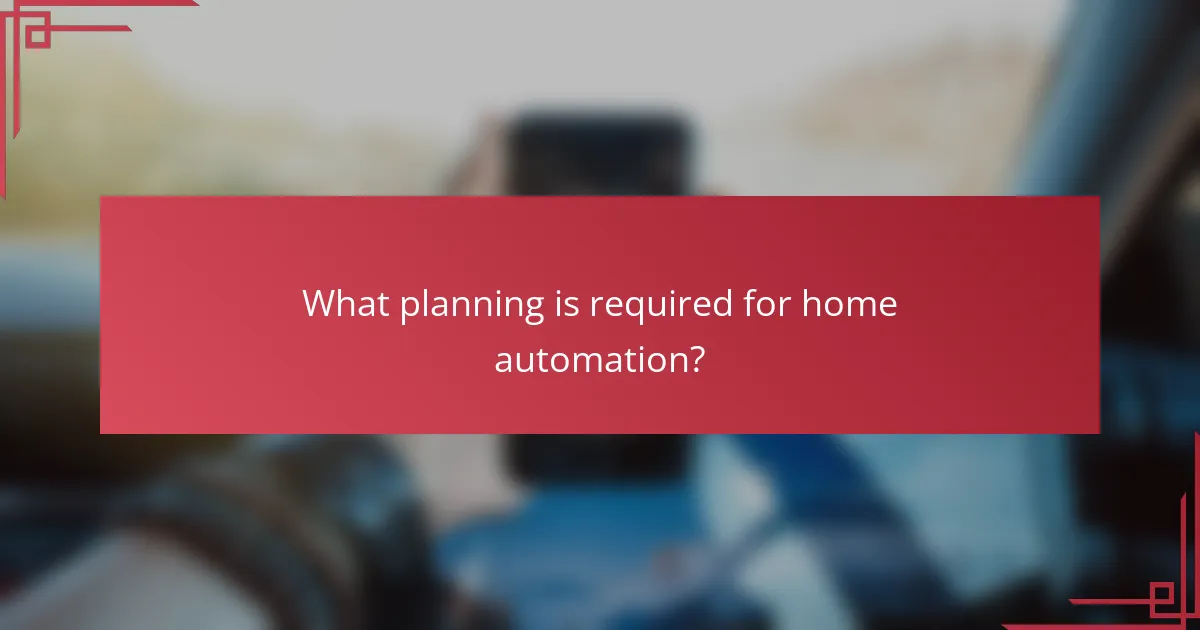
What planning is required for home automation?
Planning for home automation involves assessing your needs, selecting the right technology, and ensuring compatibility with existing systems. A well-structured plan will help streamline installation and enhance the overall functionality of your smart home.
Essential planning steps
Begin by identifying the specific areas of your home you want to automate, such as lighting, security, or climate control. Next, research various home automation systems and devices to determine which best meet your requirements and budget.
Consider the layout of your home and the location of Wi-Fi routers, as this will impact device connectivity. Creating a detailed blueprint can help visualize where devices will be placed and how they will interact.
Common pitfalls to avoid
Avoid rushing the planning phase; inadequate research can lead to purchasing incompatible devices or systems. Ensure that all components work together seamlessly to prevent future frustrations.
Another common mistake is neglecting to consider future scalability. Choose systems that allow for easy expansion, so you can add more devices as your needs evolve without significant overhauls.
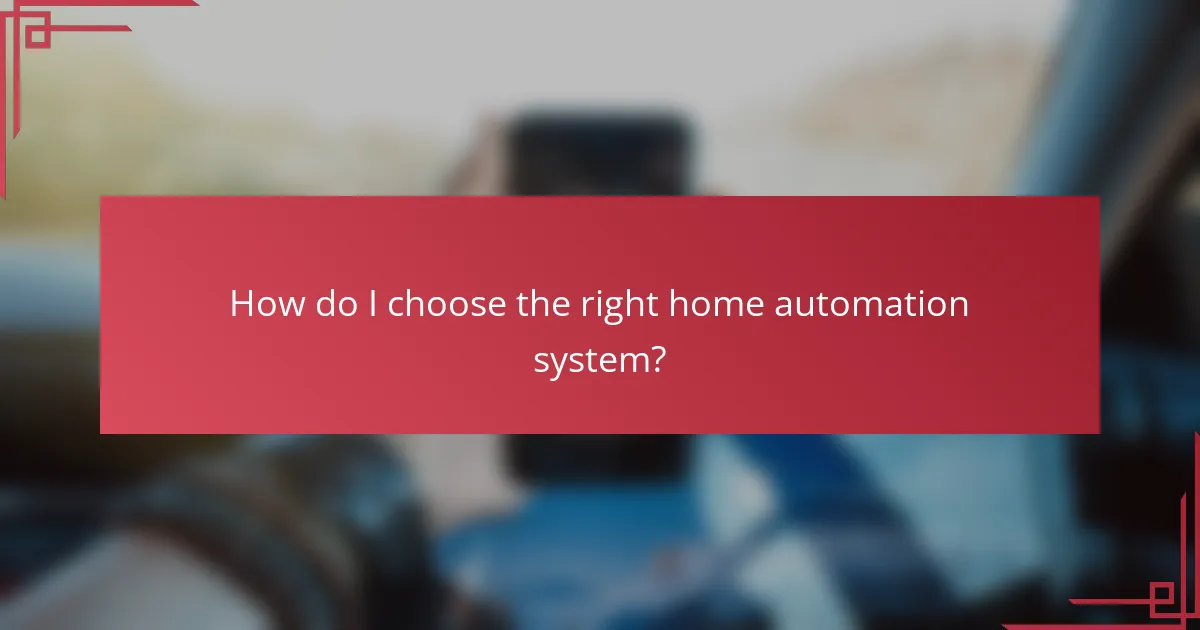
How do I choose the right home automation system?
Choosing the right home automation system involves assessing your specific needs, budget, and compatibility with existing devices. Consider factors such as ease of use, scalability, and the range of features offered to ensure the system aligns with your lifestyle.
Key selection criteria
When selecting a home automation system, prioritize compatibility with your current devices and the ability to integrate new ones in the future. Look for systems that support a wide range of protocols, such as Zigbee, Z-Wave, and Wi-Fi, to ensure seamless connectivity.
Budget is another critical factor. Systems can range from affordable DIY options to more expensive professionally installed solutions. Assess the total cost of ownership, including installation, maintenance, and potential upgrades, to make an informed decision.
Usability is essential as well. Choose a system with an intuitive interface and reliable customer support. Reading user reviews can provide insights into the user experience and help you avoid common pitfalls.
Popular brands in Ireland
In Ireland, several brands stand out in the home automation market. Philips Hue is well-known for its smart lighting solutions, offering a range of customizable options that integrate easily with other systems.
Another popular choice is Google Nest, which provides a comprehensive ecosystem for smart home devices, including thermostats, cameras, and speakers. Its user-friendly app and voice control capabilities enhance convenience.
For those seeking a more extensive range of home automation features, Samsung SmartThings offers a versatile platform that connects various devices, allowing for automation of lighting, security, and energy management. Each brand has unique strengths, so consider your specific needs when making a choice.
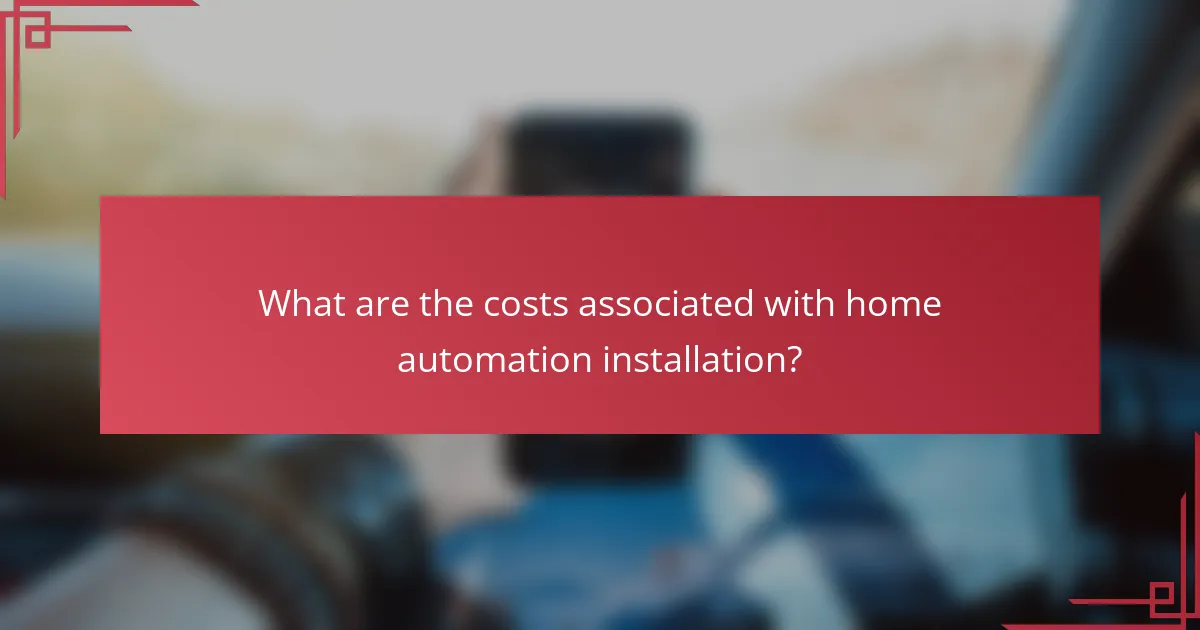
What are the costs associated with home automation installation?
The costs of home automation installation can vary significantly based on the complexity of the system and the specific components chosen. Generally, homeowners should expect to invest anywhere from a few hundred to several thousand dollars for a complete setup.
Average installation costs
On average, the installation costs for home automation systems typically range from $1,000 to $5,000. This price can fluctuate based on factors such as the size of the home, the number of devices being integrated, and whether professional installation is required.
For basic systems that include smart lighting and security features, costs may start at around $500. More comprehensive systems that incorporate climate control, entertainment, and advanced security can push the total closer to $10,000 or more.
Cost breakdown by system type
Different types of home automation systems come with varying price tags. For instance, smart lighting systems can cost between $200 and $1,500, depending on the number of fixtures and controls needed. Security systems, which may include cameras and alarms, typically range from $300 to $2,000.
Climate control systems, such as smart thermostats, generally fall between $100 and $500, while full home integration systems that connect multiple devices can exceed $5,000. It’s essential to assess your specific needs and budget to determine the best options for your home.

What are the benefits of home automation in new constructions?
Home automation in new constructions enhances convenience, security, and energy management. By integrating smart technology during the building phase, homeowners can enjoy seamless control over various systems, leading to improved efficiency and comfort.
Energy efficiency advantages
Home automation systems can significantly boost energy efficiency by optimizing the use of heating, cooling, and lighting. For instance, smart thermostats can learn your schedule and adjust temperatures accordingly, potentially reducing energy bills by 10-20%.
Additionally, automated lighting systems can turn off lights in unoccupied rooms or adjust brightness based on natural light levels. This not only conserves energy but also extends the lifespan of bulbs, resulting in lower replacement costs over time.
Increased property value
Integrating home automation features in new constructions can enhance property value, making homes more attractive to potential buyers. Properties equipped with smart technology often command higher prices, as buyers appreciate the convenience and modernity these systems offer.
Moreover, homes with energy-efficient automation can appeal to environmentally conscious buyers, further increasing demand. Investing in smart home technology during construction can yield a return on investment that ranges from 5-15%, depending on the market and features included.
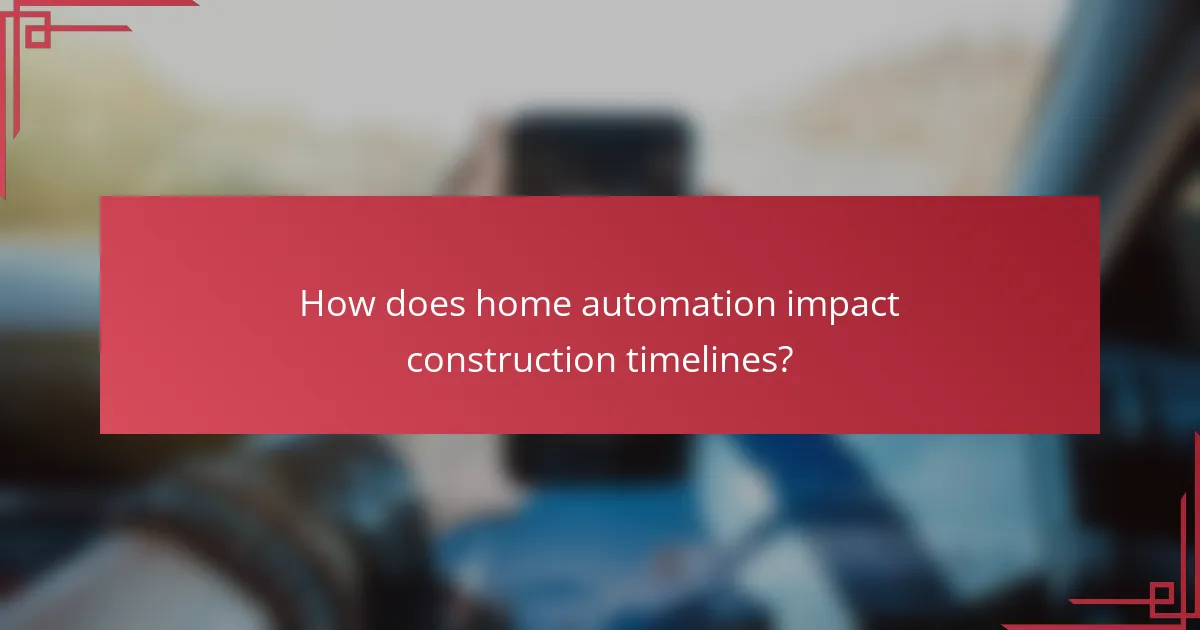
How does home automation impact construction timelines?
Home automation can significantly influence construction timelines by integrating advanced technology into the building process. Early planning and coordination with contractors are essential to ensure that smart systems are seamlessly incorporated into the design and construction phases.
Planning for home automation in new constructions
When planning for home automation in new constructions, it is crucial to identify the desired systems early in the design phase. This includes selecting smart lighting, security, climate control, and entertainment systems. Engaging with a home automation specialist can help determine the best options that align with your budget and lifestyle.
Consider the layout of your home and how automation will enhance functionality. For example, placing smart sensors in strategic locations can optimize energy efficiency and security. Proper planning can prevent costly retrofitting later, which can extend construction timelines.
Installation timeframes for home automation systems
The installation timeframe for home automation systems can vary based on the complexity of the systems chosen and the size of the home. Simple systems may take a few days to install, while more complex setups could extend to several weeks. Coordination with other trades, such as electricians and HVAC professionals, is essential to streamline the process.
It’s advisable to allocate time for testing and troubleshooting after installation. This ensures that all systems function correctly and are integrated smoothly. A well-planned installation can minimize disruptions and keep the overall construction schedule on track.
Common pitfalls to avoid
One common pitfall is underestimating the importance of early integration of home automation systems. Waiting until the end of the construction process can lead to complications and delays. Ensure that all stakeholders are informed about the automation plans from the outset.
Another issue is selecting incompatible devices or systems that do not communicate effectively. Researching compatibility and consulting with professionals can help avoid these problems. Always prioritize systems that offer flexibility and scalability to adapt to future needs.

